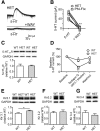Mice with compromised 5-HTT function lack phosphotyrosine-mediated inhibitory control over prefrontal 5-HT responses
- PMID: 24760870
- PMCID: PMC3996227
- DOI: 10.1523/JNEUROSCI.3762-13.2014
Mice with compromised 5-HTT function lack phosphotyrosine-mediated inhibitory control over prefrontal 5-HT responses
Abstract
The activity of the prefrontal cortex is essential for normal emotional processing and is strongly modulated by serotonin (5-HT). Yet, little is known about the regulatory mechanisms that control the activity of the prefrontal 5-HT receptors. Here, we found and characterized a deregulation of prefrontal 5-HT receptor electrophysiological signaling in mouse models of disrupted serotonin transporter (5-HTT) function, a risk factor for emotional and cognitive disturbances. We identified a novel tyrosine kinase-dependent mechanism that regulates 5-HT-mediated inhibition of prefrontal pyramidal neurons. We report that mice with compromised 5-HTT, resulting from either genetic deletion or brief treatment with selective serotonin reuptake inhibitors during development, have amplified 5-HT1A receptor-mediated currents in adulthood. These greater inhibitory effects of 5-HT are accompanied by enhanced downstream coupling to Kir3 channels. Notably, in normal wild-type mice, we found that these larger 5-HT1A responses can be mimicked through inhibition of Src family tyrosine kinases. By comparison, in our 5-HTT mouse models, the larger 5-HT1A responses were rapidly reduced through inhibition of tyrosine phosphatases. Our findings implicate tyrosine phosphorylation in regulating the electrophysiological effects of prefrontal 5-HT1A receptors with implications for neuropsychiatric diseases associated with emotional dysfunction, such as anxiety and depressive disorders.
Keywords: 5-HT transporter; 5-HT1a receptor; Kir3.1; prefrontal cortex; serotonin; tyrosine phosphorylation.
Figures



References
Publication types
MeSH terms
Substances
Grants and funding
LinkOut - more resources
Full Text Sources
Other Literature Sources
Molecular Biology Databases
Miscellaneous
